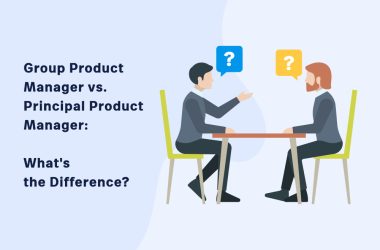Let’s say you’ve got a good thing going with continuous discovery. You’re creating a regular habit of talking to customers, you’re identifying opportunities and assumptions and building out your opportunity solution tree and starting to run small tests to explore different ideas.
Everything is going great right up until one of your stakeholders, like your CEO, approaches your team with a shiny new idea. This idea (which is probably in the form of a solution you should build) didn’t originate from your discovery work. Maybe it just came to the stakeholder spontaneously or through a conversation with someone else. In any event, this idea is not connected to any of the discovery work your team is currently doing. How should you handle it?
Let’s say a stakeholder approaches your team with a shiny new idea (which is probably in the form of a solution you should build). It didn’t originate from your discovery work. How should you handle it? – Tweet This
This is a common scenario and one that came up in the Continuous Discovery Habits community. I especially liked how several members of the community stepped in to share their thoughts on this one, so rather than a typical Ask Teresa, we’re going to share this topic in a new format, Ask the Community. We’ve summarized the responses from community members and I’ll add my own thoughts at the end.
Question: What do you do when a stakeholder has an idea that isn’t related to your outcome or your discovery efforts?
One of our community members, Rachael Jones, shared that a stakeholder came to her with a new idea for a potential solution. As is often the case, the suggestion wasn’t related to her team’s current outcome.
Rachael wondered if it made sense to assign the stakeholder’s idea to an existing outcome and conduct customer interviews to identify related opportunities. But she was concerned that this approach might lead them to “validate” the original idea that came from the stakeholder. In other words, she was concerned that confirmation bias might lead them to pay attention to signals that confirmed the stakeholder’s idea and ignore signals that negated it.
So she turned to the CDH community for help.
The Community’s Advice: Ask Follow-up Questions
One community member, Ahmed Osman, suggested working backwards by asking the stakeholder which outcome or opportunity they are trying to address.
Product Talk instructor Hope Gurion had similar advice. She suggested responding with, “Excellent idea!” and then immediately asking a series of follow-up questions. Here are Hope’s recommended questions:
Who would you expect to use that solution?
Knowing the target customer or user can help you identify which team is serving those customers and who would be best to evaluate this need.
Ask your stakeholder, ‘Who would you expect to use that solution?’ Knowing the target customer or user can help you identify which team would be best to evaluate this need. – Tweet This
What are your customers doing today and why isn’t that working for them?
Before we commit to a new solution, we want to make sure we understand what we’ll be competing with. If we can also identify where alternatives are falling short, we can quickly identify where we can differentiate.
Asking these questions can also help you and your stakeholder uncover and think through what opportunity your stakeholder is intuitively trying to address.
What is the risk of not solving that problem?
Identifying the risk of not solving that problem will help you assess the relative importance of solving this opportunity against the many others you might be encountering in your interviews or from other stakeholders.
If we had that solution, how would we measure that it was working?
This helps you define how you would measure success if you solved that opportunity and what impact on outcomes it might have.
If we had that solution, what would that do for our business?
This question helps you narrow in on what business outcome you would expect to drive by solving this need for these customers.
Ramsey Solutions: Great Idea Collaboration
Another community member, Trevor Acy, said he’s had success with Hope’s list of recommended questions. At his company, Ramsey Solutions, they coach product managers to respond with a similar set of questions that they call the “Great Idea Collaboration.” They start by acknowledging the suggestion: “Oh, that sounds like a great idea! We can definitely explore that.” Then they move on to the following questions:
- When we build it, what problem is this going to solve for our customers?
- How will we know it was successful? What will we measure?
- What other ideas did you consider before deciding on this one?
- Can our team explore some other ways we might (solve this problem) and move (measurement)?
Trevor says the purpose is to bring the person into the thinking and working on the solution together. Either they have done these things and it’s a way to get them to externalize the why behind the idea or they haven’t and you can work with them on defining the opportunity and specifying the measurable success and hopefully get permission to explore additional solutions.
He emphasizes the importance of the last question—asking if you can explore other ways to achieve the same outcome. “That way you can run the assumption testing pattern with the stakeholder’s idea as one solution plus two to four more the team comes up with.”
Ask stakeholders if you can explore other ways to achieve the same outcome. Then you can run assumption testing with the stakeholder’s idea plus a few more the team comes up with. – Tweet This
Teresa’s Advice: Story Map and Generate Assumptions Together
My suggestion is to start with story mapping and generating assumptions with the stakeholder. I want to make sure that I fully understand the idea before I start to evaluate if it’s a good fit or not. Too often, we jump to fast conclusions. So it helps to slow down and first make sure we have the full context.
Story mapping helps us align around how an idea could work for a customer. It also helps to expose gaps in our thinking and to surface underlying assumptions. When we story map with the stakeholder who generated the idea, we do this work together.
When we story map with the stakeholder who generated an idea, we expose gaps in our thinking and surface underlying assumptions together. – Tweet This
More often than not, an idea falls apart in story mapping. The stakeholder realizes the idea wasn’t fully thought through or it was more complex than what they originally thought. All ideas seem simple when they are vague concepts in our head.
If the idea survives story mapping, we can then work together to uncover the hidden assumptions the idea depends upon for success. We can work together to identify how much risk underlies the idea.
The key here is to explore and draw conclusions together. This shifts the balance from you saying no or the stakeholder saying “do this” to the two of you working together to ask, “Is this worth pursuing?”
If the idea survives story mapping and assumption generation, then I’d take the time to remind the stakeholder what we are currently working on. For example, I might remind the stakeholder of our outcome, our current target opportunity, and the solutions we are currently exploring. I’d then ask the stakeholder to weigh this idea against that other work.
There will always be times when a stakeholder changes our priorities. That’s a fact of life. But it’s our job to make sure our stakeholders know what they are giving up in exchange. This approach enables us to do that.
There will always be times when a stakeholder changes our priorities. That’s a fact of life. But it’s our job to make sure our stakeholders know what they are giving up in exchange. – Tweet This
We regularly discuss our most pressing product challenges and share potential solutions in the Continuous Discovery Habits community. You should join us there!
The post Ask Teresa (and the Community): What Do You Do With Stakeholder Feature Requests? appeared first on Product Talk.
Ask Teresa (and the Community): What Do You Do With Stakeholder Feature Requests? was first posted on December 20, 2023 at 6:00 am.
©2022 “Product Talk“. Use of this feed is for personal non-commercial use only. If you are not reading this article in your feed reader, then the site is guilty of copyright infringement. Please let us know at support@producttalk.org.








